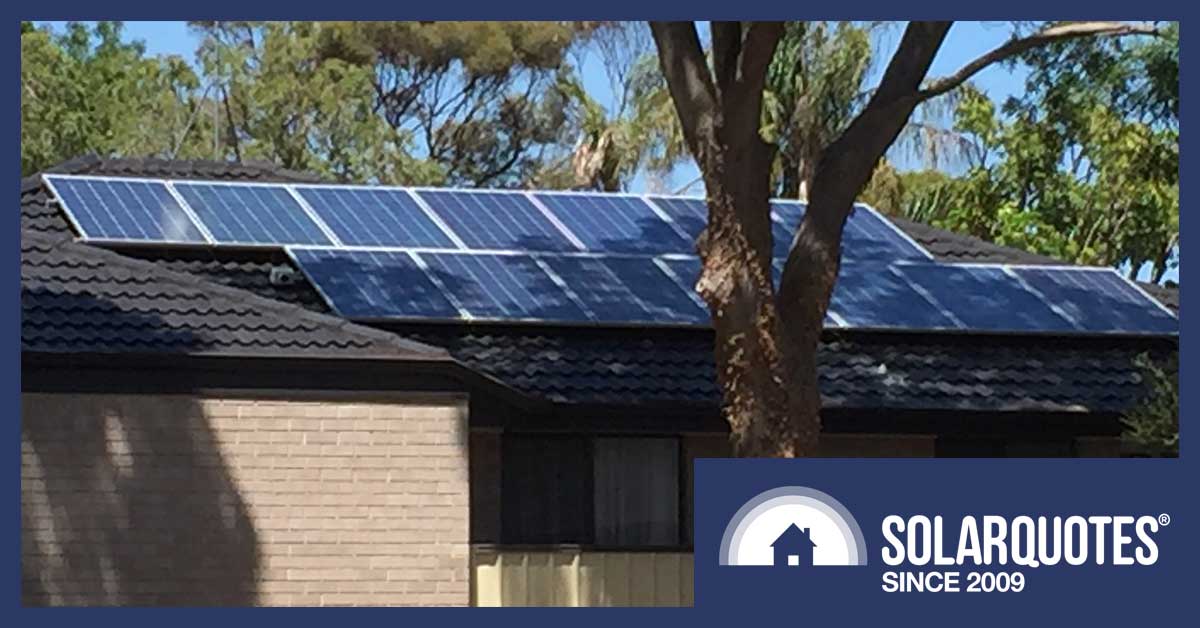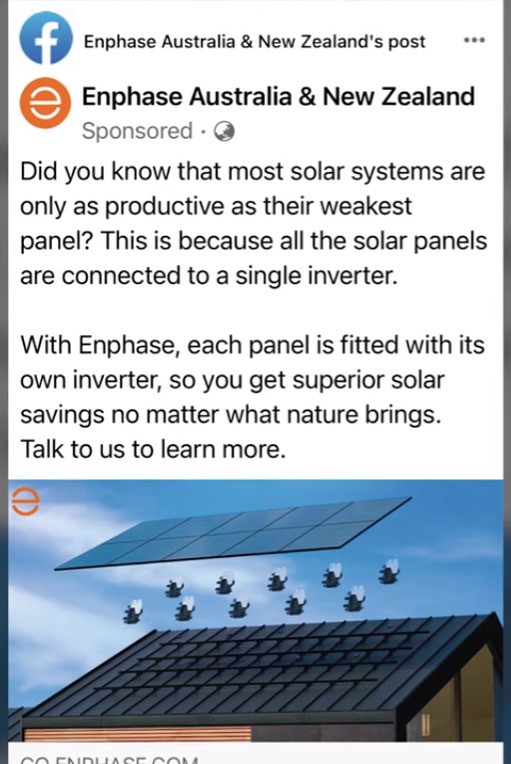
The micro-inverter debate has been stirred with two YouTube videos looking at the marketing claim that microinverters outperform string inverters when solar panels are shaded.
The simplistic claim, says MC Electrical boss Mark Cavanagh in the videos, isn’t quite accurate: in the run-off between micro-inverters and string inverters, which performs better depends on the shading conditions.
We’ll go into the details of Cavanagh’s analysis later, but what caught my eye was what had him investigating the issue in the first place. After all, if you have a bunch of solar panels producing a decent amount of power, what is there to draw your attention to whether you’re getting exactly the power you expected?
It turns out the idea first came from Managing Director of NRG Solar Eddy May, who told SolarQuotes his interest started with Enphase kit installed at the front of his warehouse in 2017.
“I noticed that when panels were only very partially shaded the performance with Enphase dropped considerably. I started to pay more attention,” he said.
May passed that observation on to Cavanagh, who decided to conduct more formal testing.
The 12-year veteran of the industry did “months of testing”, but told SolarQuotes once he started, it didn’t take long to see the patterns described in the video.
“Eddy told me this shade situation really messes with the microinverter, and when I tested, I found he was right.”
And that’s a big disconnect with how micro-inverters have been marketed, Cavanagh said.
“It got as simple as this, if you have shade you need micro-inverters. Or optimisers. And string inverters don’t work in shade, full stop.
“Sometimes it is better to have a string inverter. It isn’t a big difference, it’s fairly niche – the point is you don’t always need to pay that extra money, to get that extra production.”
Truth Lurks in the Shadows
What Cavanagh got from the work documented in his videos is a simple reset on what every electrician knows. It’s called “kink in the hose” theory – if you have one panel shaded and running at 5A, the whole string will be restricted to 5A.
That’s pretty much the premise of Enphase ads like the one below – and it’s wrong.
The problem, as Cavanagh details in that video, is solar panels don’t work so simply. They (usually) have three bypass diodes1 – and the bypass diode’s job is to decommission part of the panels if they’re in shade.
That role is purely protective. Shaded cells become power consumers instead of producers. Left to themselves, cells in this state would heat up and fail, so the bypass diodes take shaded cells out of the circuit.
Cavanagh argues that 20 years ago, string inverters’ Maximum Power Point Tracking (MPPT) software simply didn’t work as well as it does now – these days, the power loss from partial shade is far less than it used to be.
He tested Fronius and Enphase under two types of shading conditions – from the side and from the bottom – using Solar Analytics for data collection. The results for the side-shaded setup are summarised below, in a scenario where the total system loss due to Cavanagh’s artificial shade was about 15%.
| Conditions | Outcome |
|---|---|
| Sunny | Fronius 3.5% better than Enphase |
| Overcast | Enphase 2% better than Fronius |
He notes that Enphase always works a little better:
- If you have parallel strings with uneven shade;
- You have 5kW of solar power on a 5kW inverter; or
- Short strings.
String Versus Micro Inverters, Part 2
In the second video, he tested inverters under bottom-shading conditions – that is, the shading starts at the bottom of solar panels as shown below. The idea came from Dr Johnathan Dore of Solar Analytics.
If you shade (for example) four panels, the inverter chooses whether to use the four half-panels, or the eight whole panels. The string inverter has only one input, so the MPPT chooses the higher current to draw.
The Enphase microinverters on the other hand can take the highest current each panel can produce.
The best illustration is in the “extreme example”, where he shaded the bottom half of the whole string of 12 panels, and Enphase outperformed the Fronius inverter by 1%. Other results:
| Panels Shaded | Outcome |
|---|---|
| Five | Enphase 8.5% better |
| Four | Enphase 6.7% better |
| Three | Enphase 6.3% better |
And as it happens, in side-shading, he said,
“one shaded cell takes out the whole string” is a scenario you’ll more likely encounter using micro-inverters!
“Panels on a microinverter system only have to deal with a little bit of energy [from one panel].”
That means it’s rare that the bypass diode ever engages on a microinverter panel – so one shaded cell string will drag down the power of the whole panel.
Enphase had little to say on the topic. Marketing manager APAC Justin Cohen told SolarQuotes:
“As you’re aware, there are heaps of backyard enthusiasts in solar and we love that there is so much passion in the industry at all levels. Where productive, we invest a lot of time into keeping these dialogues open with the industry at large. However, manufacturers simply don’t have the time to respond to every one of these rabbit holes.”
With that campaign done, Cavanagh has decided to take shading and warranties up to solar panel manufacturers as his next mission.
Manufacturers generally keep shading as a get-out-of-warranty card, since shading can be hard on bypass diodes. Since it’s hard to imagine almost any location that can be guaranteed shade-free for the warranty life of a solar panel, it’s a good battle to fight.
Footnotes
- Six on a half-cut panel ↩


 RSS - Posts
RSS - Posts



“Backyard enthusiast”. That cuts deep.
I’ve put the testing stage in my backyard at work. Perhaps that’s me. Haha
Was pretty funny you must admit. Are we going to see a reply video mark?
Why do you recommend foil modules ? if DNV-GL NREL and PVEL recommend high durability double glass https://www.linkedin.com/in/krzysztof-dorynek-06a8b2b3/recent-activity/#
Mark, I have 3 strings of 8 and 8 and 7 Sunpower Panels a total of 7.5kw with Fronius Inverter. Shading is a problem I was aware of and it was recommended on installation in 2019 that I put Tigo switches on every panel which I did.
After 6 months I noticed my production via emberpulse monitoring was not what I expected. It took a while but the installers came out and found 6 of the Tigo switches on the 1st string had failed leaving only 2 panels on that string working. The Tigo’s were replaced under warranty.
My system is again well below production compared to what it was the same month last year. In fact the system has dropped by 54% some months on comparison to when it was 1st installed.
They are coming out again to temporary put a Tigo monitoring system on but I know that will only confirm that the system is again faulty.
Do you have any question for me to ask when the come back out. The installers are highly recommended and the system was over $12,000 so I did not take any cheap options.
I also heard that Tigo optimisers do not work well with Sunpower panels but work well with LG and other panels.
Can you help
Sunpower are excellent panels
You’ve got paralleled strings into one of the mppts.
What suburb are you in? I’d love to see what’s going on.
Queens Park, Sydney’s Eastern Suburbs
SMA has spend considerable amount of blog posts detailing no benefit from microinverters or dc optimizers.
My system was installed in 2013. I have 30 SolarWorld mono panels (15×250 and 15×260 Watts) and Enphase M215 microinverters, the panels are installed in the landscape orientation. My system reports to pvoutput.org. After 8 years it is ranked in the top 4%-5% of all systems on that site world-wide, based on the average output per time period per kW installed (i.e., efficiency). Something must be going well with my system. (https://pvoutput.org/list.jsp?id=22322&sid=20215)
Yes, I did pay more for this system than someone who opted for a string or DC optimizer, but the results have been fantastic.
I think that here are two different situations here. The claim for microinverters is based in partial shading of an installation, ie some panels in the sun, others in the shade, connected in series. The video is dealing with partial shading of an individual panel. I see no reason to expect that microinverters will be better for that.
The claim that modern panels have bypass diodes on panel sections to mitigate part panel shading loss is interesting. They may also help with shading of some panels. It would be interesting to test that.
Has this been done for SolarEdge optimisers/inverters?
Looks tricky to assess it seems what is the best bang for the buck in some circumstances. I had one quote that suggested micro inverters over 2 strings ( due north and west) and I couldn’t see how they would benefit me given I have no tree shade issues just a shade transition late arvo from the lower to the upper floor which occurs so late that my output loss isn’t much anyway. Monitoring for 3 years now with PVoutput and I compare my output to 3 systems locally that are a mix of similar panels and layout and one that uses micro inverters. On a cloudy day the micro inverter system out performs me but I think I made the right choice not to go with it on price/output gain overall. Now I’m thinking of more panels on the east side with micro inverters or an extra inverter but I wonder if it’s worth it. Great and interesting article.
I’ve had both systems in my place, string and micro. The micros far out performed the string in all situations.
Shade issues are only one of at least twelve reasons why people buy micro inverters before even getting into batteries.
It also depends on the type of shade, a power pole or palm tree compared to a hill or building.
Over 70% of people who choose micro inverters have no shading at all so to be objective it is important to put this into context with all of both products features when making the overall purchase decision.
Even then you would never be comparing like for like.
Really helpful information videos there from Mark.
These videos are great info and show that string converters have come a long way.
The marketing of enphase is nice but these tests show that their claims are wrong. calling you guys backyard really says enough.
question will be can enphase still use their marketing knowing it’s wrong, in some European countries they could have problems because of this.
when looking at other trials using shade the same results are shown.
enphase might be a solution but in maybe 5% of all situation.
But when you look more close, enphase has up to 400% more connectors on the roof. This is 400% more failure points.
The 25 year guarantee is nice but will they last 25 years ?
what happens if they go out of business in 10 years, one of the unit fails no replacements what than.
If your string inverter fails you can replace it with any brand.
I think enphase uses nice marketing, cost more but in 95% of all situation no added value.